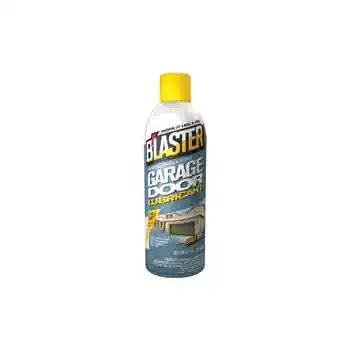There’s nothing worse than a sluggish or noisy garage door. It only takes a few minutes to lubricate a garage door to make it run like new again!
Like most things, the metal parts of your garage door need a little preventative maintenance to keep working the way they should.
Lubricating your garage door at least once a year should be part of your maintenance process.
However, you can follow this process whenever you have a noisy garage door.
Blaster Silicone-Based Garage Door Lubricant |
WD-40 Specialist White Lithium Grease Spray |
Gear Hugger Multipurpose Lubricant |
|
Primary Rating:
4.0
|
Primary Rating:
4.4
|
Primary Rating:
3.7
|
What Should You Use to Lubricate A Garage Door?
You’re probably used to grabbing that can of WD-40 and spraying the tracks.
Well, put it back down.
We’ll cover how and when to use regular WD-40 later, but people who use it to lubricate their garage doors do more harm than good.
If you go to the garage door lubricant section of your local Lowe’s or Home Depot, you’ll see a lot of options, but they can be broken down into one of two types:
- Lithium-based grease
- Silicone-based lubricants
But what’s the difference, and which should you use?
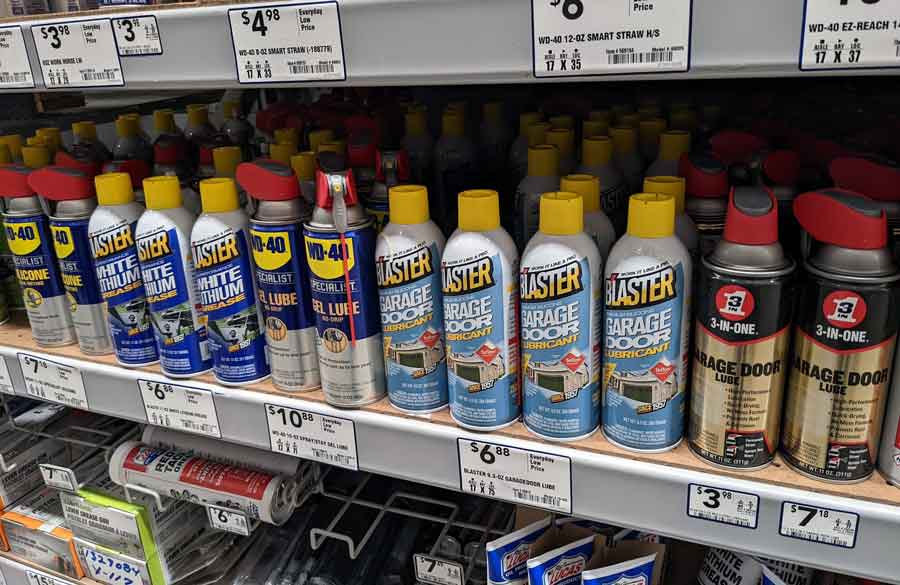
Garage Door Manufacturers Recommended Lubricants
Always start with what the manufacturer recommends.
I scoured the owner’s manuals for the five major garage door manufacturers to see if they recommend one type of lubricant over another.
Most had very specific garage door maintenance recommendations.
Some of them were surprising.
Amarr recommends lubricating their garage doors yearly with “Amarr Super Lube or similar non-silicone-based lubricant (e.g., 10W-30 motor oil).”
Cloplay recommends lubricating their garage doors “at least twice per year…with Clopay Garage Door Pro Lube or a synthetic lubricant.” Although they don’t prohibit using a silicone-based lubricant, it’s worth noting that their product does not contain silicone.
Overhead Door doesn’t specify a type of lubrication for their garage doors beyond saying that “a 30w or other medium weight oil is satisfactory.”
Raynor is the only garage door manufacturer to recommend a “silicone or Teflon® based spray.” They also warn against using “WD-40 type lubricant (oil based) or grease.”
Wayne-Dalton, which is who makes my garage door, recommends a “non-silicon-based lubricant.”
- Ideal for metal-to-metal applications that require heavy-duty lubrication and protection against rust and corrosion
- Sprays on evenly as a liquid and sets dry for a thick, protective coating that won't run off. Safe from 0° F to 300° F for unbeatable protection
Can You Use WD-40 to Lubricate a Garage Door?
I love WD-40.
It’s a great spray cleaner and degreaser.
But you shouldn’t use it to lubricate a garage door. In fact, Raynor specifically told us not to use it.
But why?
The ‘WD’ in WD-40 actually stands for Water Displacement. That means it’s designed to help remove rust by breaking down the chemical bonds on oxidized metals.
Sorry…I was a chemistry geek in high school. It comes back sometimes.
The critical part to remember is regular WD-40 is great at getting rid of rust or accumulated oils and gunk. It’s cleaning, not lubricating.
However, I’ve got good news if you’re a die-hard WD-40 fan.
WD-40 makes a White Lithium Grease specifically for lubricating garage doors, which we’ll use today.

I’m not saying that you need to use a WD-40 product or that this is the best garage door lubricant.
Any White Lithium grease will do the job.
Note: If you have a Raynor garage door, swap out the lithium grease for a silicone lubricant, as they recommend. The steps below remain the same.
Why white lithium or silicone lubricant to fix squeaky garage doors?
You want your garage door lubricant to cling to the parts, not run down the side of your door. The advantage of both lithium grease and silicone is it stays where you spray it.
Look at this comparison: On the left is regular WD-40, and on the right is lithium grease.

You can see how much regular WD-40 runs after only two seconds.
Which will lubricate a garage door longer?
How Do You Lubricate a Garage Door? (Step by Step Guide)
Now that we’ve got the right tools, let’s get started. By the end of this section, we’ll lubricate the moving parts on your garage door system.
Grab your lithium grease or silicone spray and some old rags to clean up any excess lubricant.
You may also need a step ladder to access any out-of-reach areas.
Since they’re usually right next to each other, we’ll start by hitting both the rollers and the hinges at the same time.
How to Lubricate Garage Door Rollers & Hinges
Garage door rollers have two parts that need lubrication: the ball bearings inside the roller wheel and the metal shaft that slides in the bracket on the door.
To start, spray some grease at the edge of both sides of the bracket (as shown below).
If you get the angle correct, this should force grease into the entire bracket.

Don’t be stingy here.
Our goal is to spread the grease evenly along the entire shaft when we open and close the door.
Do the same for each hinge, including the hinges along the center of the door.
The hinges hold the door together while it moves up and down the track, so they take a lot of abuse.
Similar to how we lubricated the roller’s shaft, spray Lithium grease on any of the door hinge’s moving parts. We want the oil to spread evenly and lubricate the entire hinge.
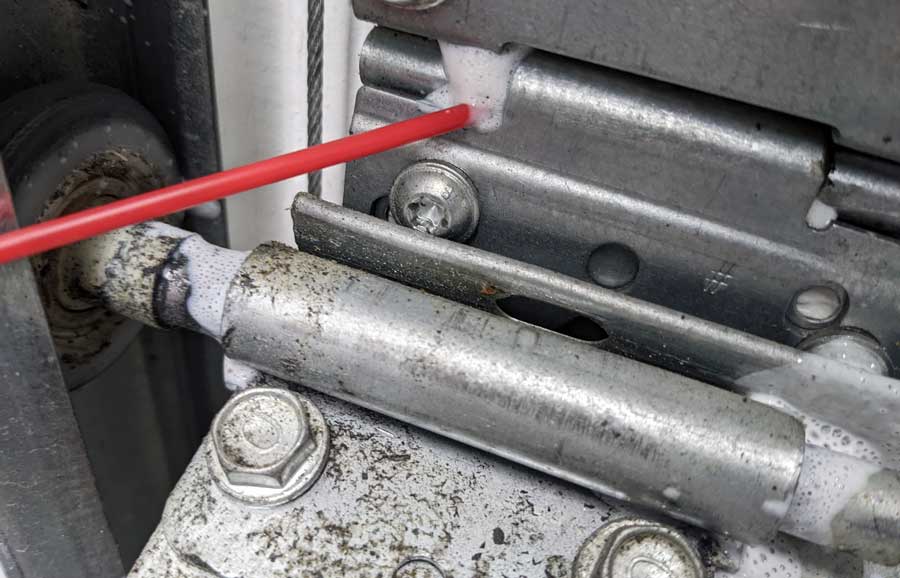
While you’re here, check to see if any bolts are loose, tighten them up, and look for miscellaneous garage door parts that need to be repaired or replaced.
Finally, it’s a good idea to take a clean, damp rag and wipe off any accumulated dirt, dust, or debris on the roller wheel.
Rollers: Lubricating Ball Bearings (optional)
Depending on what type of garage door rollers you have, this step will be optional.
Many rollers will have tiny ball bearings inside to help them move freely.
If you have rollers with exposed ball bearings, shoot a little grease on them so they keep moving freely. Some rollers, like these DURA-LIFT rollers, have a sealed system, so there’s nothing to lubricate.
- Reduces garage door noise by at least 75% compared to standard steel rollers
- 6200ZZ Bearing rated for 200,000 door open and close cycles
- Front and back sealed caps prevents dust & grime from penetrating roller
- Lubrication groove on roller to disperse lubrication over extended period
- 100% Lifetime Guarantee
Similarly, plastic rollers don’t have bearings, so there’s nothing to lubricate.
However, plastic rollers weren’t designed to last more than a few years. If you’ve got these on your door, you should look to replace your garage door rollers with nylon rollers as soon as possible.
Garage door lubrication: Door Arm
The garage door arm connects the pulley to the door, and it has two moving parts that we need to lubricate.
At the bottom of the arm is a simple hinge where the arm meets the top of your garage door.

Clean off any visible dust buildup with a damp rag, then spray lubricant on any connection points to keep them running smoothly.
Next, do the same with the upper garage door arm where it meets the trolley.
This is the part that moves back and forth along the center track.
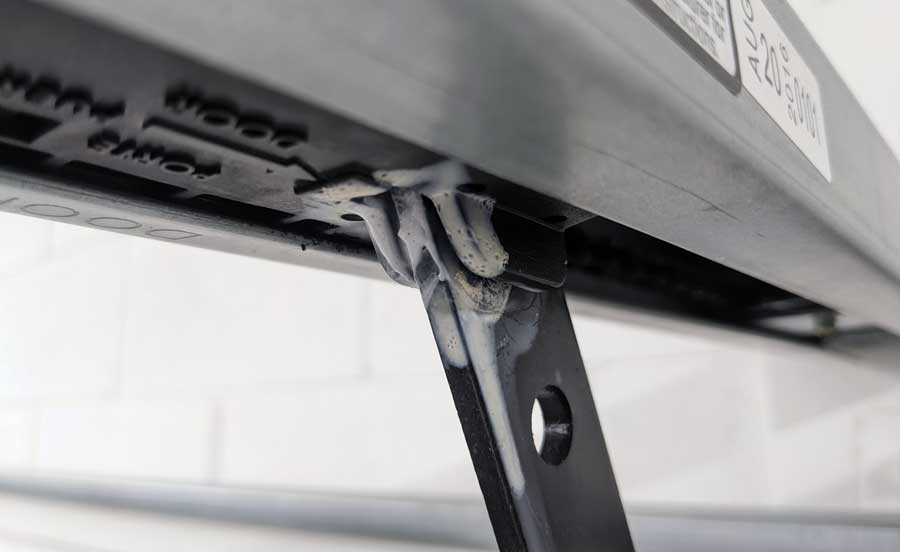
Remember to clean off any excess grease right away.
Garage Door Lubrication: The Center Rail
Here’s where I had it all wrong.
I was spraying the bottom of the garage door opener’s center rail, thinking it would help.
It doesn’t.
Think of the track like an upside-down ‘T.’
Your garage door opener has a trolley that runs along the top edge of the track. If you lubricate the bottom of the track, you’re spraying things that will never get touched.
You should spray the TOP edge of the center track, which makes contact with the edges of the trolley as it moves along, pulling the door up.
In my case, the track is almost completely enclosed, which shields it from any dust or debris that can get in and clog up the system.
It doesn’t mean that I get a free pass and never have to lubricate this section.
Clean (Don’t Lubricate) Your Garage Door Tracks
A common misconception is that you must lubricate a garage door’s track to help the rollers move up and down.
That’s actually doing more harm than good.
Because the track is exposed to the outside air, any sticky substance (like grease) will attract dirt and dust. This causes more friction and slows the rollers as they run over it.
This will make your garage door opener work harder and a lot noisier.
There’s one and only one place on the track that could use a little grease to keep things running smoothly.
Look at the corner of the track, which has raised bolts holding the track pieces together. Spray a little lubricant on the bolts to make it easier for the rollers to run over them.
How to Clean Your Garage Door Track
Remember that can of the original WD-40 I told you to put down earlier?
Here’s where you can use it.
As mentioned, the regular WD-40 with the red cap is a fantastic cleaner and degreaser.
If you’ve got any gunk, grime, or other nasty buildup on your garage track, spray a little WD-40 on it, wait a minute, and wipe it off.
Feel free to use a scouring pad on the more challenging spots.
The goal is to get the track as clean as possible so that the roller wheel slides along with as little drag as possible.
I also recommend looking at your garage door sensors to clean off the lenses and ensure they operate correctly.
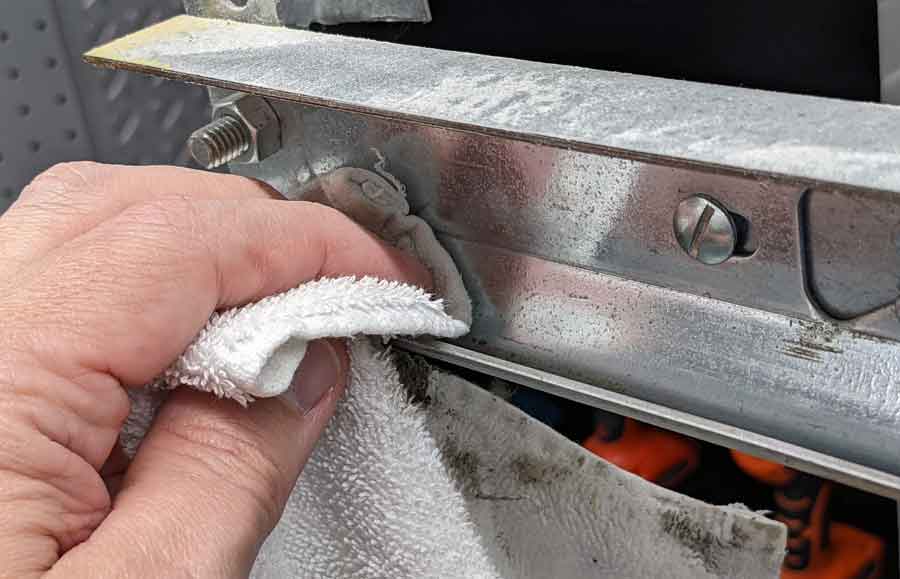
Final Step: Open the door
The final step is to open and close the garage door several times.
I like to do five or six complete cycles (opening & closing) to ensure the grease is spread evenly across all the parts.
While your door operates, listen for any squeaks or groans where you may need additional lubricant.
Your garage door should open and close smoothly. It should also be much quieter than before, even if you didn’t think it was that loud in the first place.
Because I had a new home, my door wasn’t that noisy, but it had started stuttering as it opened.
Five minutes of TLC, and it was like I had a brand new door again.
Wrapping It Up
Depending on how often your door is used, you should be lubricating your garage door at least once a year.
However, if you’re like me, you probably only start thinking about garage door lubrication when it starts getting slow or noisy.
Still, it’s important to stay current on your garage door maintenance schedule.
If your garage door is still noisy or sluggish, it may be time to call a garage door repair professional.

